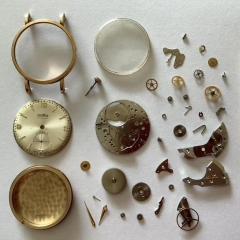Unknown watch movement logo. Very interesting
-
Recently Browsing
- No registered users viewing this page.
-
Topics
-
Posts
-
Thanks for that Andy, Yes the new bracelet is worth more than the watch itself, Its one I have bought to service and clean-up and on-sell it as a project, look it may sell to someone who has a small wrist, I think I will buy an extender and may-be offer it up with a normal strap as well CJ
-
Not always that simple. Typically the only reason we would have any way of identifying a watch is if parts were available at any time and somebody had a parts reference book then they would help you to identify the watches that they have parts or. Unfortunately there are hundreds of thousands of watch movements with no identification and of course typically no parts the classic place were watches would be identified would be under the balance wheel and your pictures don't really show a good view of that. Occasionally I've seen watches marked under one of the plates. They felt very proud of their watch is a very prominent Swiss company and they ask he stamped the bottom of a plate so you have disassembled find it. Then there is the other system the keyless parts make up something called the fingerprint system but you still haven't given us enough information to make use of that. Here's an image showing what a fingerprint system looks like. The PDF is based on the physical book the physical book has sizes of watches these are smaller ladies watches and keyless parts which in the physical book are printed at the actual size of the watch parts. So to identify with the keyless we need in your case diameter measured on the dial side and a good picture of the keyless parts and then you have to hope that this was made within the right time span of the books that have this system on the other hand a lot of times on the dial side they will also put markings. So basically to identify a movement it has to come out of the case and has to be disassembled.
-
The strap is a 44Q6JB and hadn't realised how much they'd gone up in price. The used one I've got is very worn but may have other links floating around.
-
@Mercurial is this also a variation of the tool you posted?
-
Thanks Andy, The bracelet is sized very small, around a 14cm wrist. Were would one try to source original links, I guess they wouldn't be cheap if found. The bracelet end links have 4406 B-E stamped on them, is this the Seiko Bracelet code ?? CJ
-





Recommended Posts
Join the conversation
You can post now and register later. If you have an account, sign in now to post with your account.
Note: Your post will require moderator approval before it will be visible.